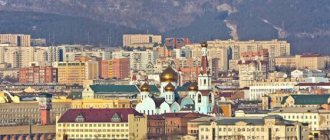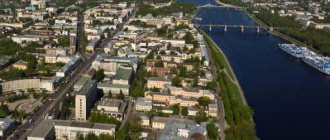While Russia as a whole has recorded positive natural population growth, which is happening for the first time since the collapse of the Soviet Union, then in Murmansk everything is different. The demographic situation in the region has remained consistently negative since the 1990s: the population of Murmansk is leaving their small homeland, high mortality is characteristic (especially among men of working age), except that the natural decline has decreased in recent years due to an increase in the birth rate.
Climatic conditions
The weather in Murmansk is quite unpredictable: the sun can shine in the morning, but in the evening it becomes cold. This is due to the fact that the city is located in the Atlantic-Arctic zone. The climate of Murmansk is considered moderate.
During the polar night, the sun practically does not appear. This negatively affects the health of people who have chronic pathologies. It is most difficult for those who suffer from cardiovascular diseases.
In autumn and spring the city is beautiful, but very cold. If it rains, it turns into a big muddy puddle.
During the May holidays it is cold and snowy. The polar summer is very short-lived; there are very few truly warm days.
Temperature by month
| Month | Temperature |
| January | −12,6 |
| February | −7,7 |
| March | −3,7 |
| April | +0,2 |
| May | +5,5 |
| June | +9,1 |
| July | +15,1 |
| August | +12,1 |
| September | +7,8 |
| October | +1,5 |
| November | −2,6 |
| December | −6,8 |
The last city founded under the Russian Empire
Murmansk, which currently has a population of 301.5 thousand, was founded in 1916, although plans for a port city began to appear in the 1870s. The main purpose of creating the settlement was the desire of the Russian Empire to gain access to the Arctic Ocean through the gulf, which does not freeze, so that in the event of a blockade of the seas, the Black and Baltic, to be able to supply and receive cargo.
Initially, the city was a small village of Semenovsky at the Murmansk seaport. The official founding date of the settlement is the day of foundation of the temple in honor of the patron saint of sailors. Murmansk (the population at the time of its founding consisted mainly of workers and members of their families) became the last settlement that was founded during the Russian Empire, and received its modern name six months after the February Revolution. Until this moment, the settlement was called Romanov-on-Murman.
Districts and real estate
Main districts of Murmansk:
- Leninist;
- October;
- Pervomaisky.
One of the best areas of the city is Northern Nagornoye. There are quite a few nine-story buildings here, quite well maintained. The road condition is good, public transport runs without delays.
Nearby there are schools, clinics, shops, as well as a large shopping center.
Apartment prices
The cost of real estate in Murmansk looks like this:
- 1-room — 2,100,000 rub.
- 2-room - 2,550,000 rub.
- 3-room — 3,190,000 rub.
House prices
A good house can be purchased both in the city itself and outside it. Many buildings are in excellent condition. They are gasified and equipped with all amenities.
The cost of houses varies from 1,550,000 to 8,330,000 rubles.
Demographic situation during the war
During the war, the city was repeatedly subjected to air attacks. In terms of the number of bombings and the density of the shells, Murmansk, whose population lost three-quarters of its buildings, is second only to Stalingrad. German troops made two attempts to capture a settlement of strategic importance, but both of them failed.
The population of the city during the period of hostilities decreased by only nine thousand people (data from 1939, when the number of residents was 177 thousand, and 1956, when 168 thousand citizens lived in Murmansk, are taken into account). The bombings took the lives of many, but the losses were made up by newcomers. By 1944, with the start of the offensive operation of the Red Army, the threat to Murmansk was removed.
Cost of products
Grocery prices in Murmansk look like this:
Cost of fresh vegetables in Murmansk
- Butter - 73 rub.
- Rice - 54.90 rub.
- Bread - 27.40 rub.
- Potatoes - 29.90 rubles/kg.
- Apples - 76.90 rubles/kg.
- Eggs - 80.90 rub./10 pcs.
- Cheese (hard) - 200 rub./100 g.
- Pork - 259 rub./kg.
- Milk - 80 rub./l.
- Flour - 30 rubles/kg.
- Fish - 250 rub./kg.
Watch a video about how much life costs in Murmansk.
What is the population of the city of Murmansk?
| Murmansk region | 732 864 | 675 190 | 57 674 |
| Urban district of the city of Murmansk | 282 851 | 282 851 | 0 |
| Murmansk | 282 851 | 282 851 | 0 |
| Aleksandrovsk Urban Okrug (ZATO) | 45 340 | 43 278 | 2 062 |
| Polyarny | 17 280 | 17 280 | 0 |
| Gadzhievo | 13 016 | 13 016 | 0 |
| Snezhnogorsk | 12 982 | 12 982 | 0 |
| Urban district Vidyaevo village (ZATO) | 5 719 | 0 | 5 719 |
| Vidyaevo settlement | 5 719 | 0 | 5 719 |
| Urban district city of Zaozersk (ZATO) | 9 120 | 9 120 | 0 |
| Zaozersk | 9 120 | 9 120 | 0 |
| Urban district city of Ostrovnoy (ZATO) | 1 702 | 1 640 | 62 |
| Ostrovnoy | 1 640 | 1 640 | 0 |
| Urban district of the city of Severomorsk (ZATO) | 65 080 | 60 318 | 4 762 |
| Severomorsk | 54 473 | 54 473 | 0 |
| Safonovo village | 5 845 | 5 845 | 0 |
| Urban district of Apatity | 53 850 | 53 847 | 3 |
| Apatity | 53 847 | 53 847 | 0 |
| Urban district city of Kirovsk | 28 086 | 25 944 | 2 142 |
| Kirovsk | 25 944 | 25 944 | 0 |
| City district Kovdorsky district | 17 717 | 15 850 | 1 867 |
| Kovdor | 15 850 | 15 850 | 0 |
| Urban district city of Monchegorsk | 44 412 | 40 675 | 3 737 |
| Monchegorsk | 40 675 | 40 675 | 0 |
| Urban district city of Olenegorsk | 29 547 | 19 887 | 9 660 |
| Olenegorsk | 19 887 | 19 887 | 0 |
| Pechenga Municipal District | 36 090 | 28 607 | 7 483 |
| Zapolyarny | 14 330 | 14 330 | 0 |
| urban settlement Nikel | 10 763 | 10 763 | 0 |
| Pechenga village | 3 514 | 3 514 | 0 |
| Urban district city of Polyarnye Zori | 16 396 | 14 230 | 2 166 |
| Polyarnye Zori | 14 230 | 14 230 | 0 |
| Kandalaksha municipal district | 40 722 | 34 936 | 5 786 |
| Urban settlement Kandalaksha | 31 678 | 29 750 | 1 928 |
| Kandalaksha | 29 750 | 29 750 | 0 |
| Urban settlement Zelenoborsky | 5 644 | 5 186 | 458 |
| village Zelenoborsky | 5 186 | 5 186 | 0 |
| Rural settlement Alakurtti | 2 829 | 0 | 2 829 |
| Rural settlement Zarechensk | 571 | 0 | 571 |
| Kola municipal district | 40 293 | 31 695 | 8 598 |
| Urban settlement Kola | 9 560 | 9 560 | 0 |
| Kola | 9 560 | 9 560 | 0 |
| Urban settlement Verkhnetulomsky | 1 218 | 1 213 | 5 |
| Verkhnetulomsky village | 1 213 | 1 213 | 0 |
| Urban settlement Kildinstroy | 4 952 | 1 946 | 3 006 |
| village Kildinstroy | 1 946 | 1 946 | 0 |
| Urban settlement Molochny | 4 829 | 4 810 | 19 |
| village Molochny | 4 810 | 4 810 | 0 |
| Urban settlement of Murmashi | 13 730 | 13 730 | 0 |
| Murmashi village | 13 730 | 13 730 | 0 |
| Urban settlement Tumanny | 436 | 436 | 0 |
| the village of Tumanny | 436 | 436 | 0 |
| Rural settlement Mezhdurechye | 1 764 | 0 | 1 764 |
| Rural settlement Pushnoy | 937 | 0 | 937 |
| Rural settlement Teriberka | 595 | 0 | 595 |
| Rural settlement of Tuloma | 1 868 | 0 | 1 868 |
| Rural settlement Ura-Guba | 404 | 0 | 404 |
| Lovozero municipal district | 10 848 | 7 925 | 2 923 |
| Urban settlement Revda | 7 925 | 7 925 | 0 |
| Revda village | 7 925 | 7 925 | 0 |
| Rural settlement Lovozero | 2 923 | 0 | 2 923 |
| Tersky municipal district | 5 091 | 4 387 | 704 |
| Urban settlement of Umba | 4 413 | 4 387 | 26 |
| Umba village | 4 387 | 4 387 | 0 |
| Rural settlement Varzuga | 678 | 0 | 678 |
With the population of the city of Murmansk as of January 1, 2022, how many people live in this territory, people in municipalities and this locality, this territorial unit of the Russian Federation, that’s what we figured out here, we made our contribution to satisfying the requests of those interested in this statistical information .
Unfavorable days in 2022, difficult for health and well-being
Lunar calendar for hair cutting 2022, favorable days to cut hair
Work situation
The most popular industry in Murmansk is trade. Other popular areas of activity:
- Logistics.
- Medicine, pharmaceuticals.
- Construction.
- Production.
- Transport, car service.
Where can I get a job?
You can find work in the companies listed in the table.
| Company name | Number of vacancies in 2022 |
| Group of window companies | 1891 |
| Gorenje BT | 1800 |
| Bilinguals | 1740 |
| Industrial Safety Group | 1732 |
| Center | 373 |
| Company group | 335 |
| BY | 173 |
| Youth | 151 |
| Service+ | 135 |
| Alexander | 133 |
Most in-demand professions
In 2022, the following professions are considered in demand:
- Public transport driver.
- Internet manager.
- Office Manager.
- Store manager.
- Online store manager.
- Manager-administrator.
- HR specialist.
- Taxi driver.
The highest paying professions
The following specialists receive high salaries:
- Welder NAKS - 95,000 rubles/month.
- Anesthesiologist-resuscitator - 80,000 rubles/month.
- Driver category "E" - 80,000 rubles/month.
- Taxi driver - RUB 70,000/month.
- Resuscitator - 67,500 rubles/month.
- Crane operator - 60,000 rubles/month.
- Chief engineer - chief technologist - 57,500 rubles / month.
- Designer - 55,950 rub./month.
- Designer-technologist - 55,800 rub./month.
- Process engineer - designer - 55,000 rubles / month.
Is it worth going?
Moving to Murmansk can be a real stress for people who are not used to the polar night, which lasts 45 days. The city also experiences a polar day. It is characterized by the presence of sun both in the morning and at night.
According to local residents, life in their city is unreasonably expensive.
Salaries in Murmansk are higher than in many other Russian cities, but the money is spent on purchasing the basic necessities.
The minimum payment for housing and communal services in a two-room apartment in which no one lives is 6,000 rubles. Residents pay for heating all year round. It is disconnected in June and connected in September.
A family living in a two-room apartment pays 8,000–10,000 rubles every month.
A family of three spends on average 20,000–25,000 rubles a month on groceries.
Products are not always of good quality. According to Murmansk residents, goods ripen on the road. Even in the refrigerator they quickly deteriorate.
People, tired of the “plastic” taste, are trying to grow strawberries and apples in their dachas. But they do not have time to mature and grow very small.
The city center is quite beautiful. But in many microdistricts, especially on the outskirts, the situation looks sad. There are sad Stalin buildings that merge in an ugly ensemble with even more disgusting rotting wooden buildings.
The age of these houses is 70–80 years. These barracks have neither sewerage nor running water. They consist of gypsum blocks with wooden floors.
According to the federal program, they were supposed to be gradually demolished and people were to be relocated to more comfortable houses. The program ended in 2022. Many old wooden houses, in disrepair, were never demolished.
There is a lot of garbage in the city. The roads are in poor condition. On the outskirts the snow is never cleared.
Advantages and disadvantages of Murmansk
Negative reviews about the city
Real reviews of people who moved to Murmansk for permanent residence.
Sergey : “Local 30–40 thousand is like about 20–25 thousand in other cities of Russia. Products and services here are much more expensive than in St. Petersburg. and in Moscow. But at least there is a choice for all categories of citizens, but here everything is very expensive.
Sitting in a cafe with your family costs at least 2,000 rubles. This is the case if you do not take alcohol.
There are practically no good specialists in the city. Almost all of them left, some abroad, some to other regions of Russia, where it is warmer. There is practically no competition, so almost all services here are of disgusting quality.
Recently, a lot of people have appeared from the Caucasus and Central Asia. I don’t know if this has anything to do with the fact that there is more garbage in the city. However, perhaps this is due to the fact that the situation with garbage disposal is also disgusting.”
Pavel : “In my opinion, you shouldn’t move to Murmansk for permanent residence. Working on a rotational basis, yes, but living here is very difficult.
Depressive city. Every year it gets worse. Everywhere there is only tons of garbage, dull, faceless houses. Automobile factories have not been built for a long time, and the electronics industry has not developed.
The living wage for those who do not work is only 12,400 rubles, the maximum living wage for those working is 15,400. Prices are sky-high. There are a lot of stores with synthetic products.”
Watch a video about life in Murmansk.
Positive reviews about the city
Igor : “In my opinion, Murmansk is a very beautiful city. I love the polar night, and my body perceives the transitions normally.
Almost a European city - Scandinavia is very close. Our city is the largest in the Arctic Circle. A small thing, but still nice.
Everything in the city is arranged for normal life. You can find a suitable job. The main thing is not to be lazy and constantly improve yourself. And good specialists are highly valued here.
Yes, summer is short here. But we try to go somewhere to the sea every year. If a large family cannot afford a trip, then free trips are issued for children.”
Artem : “The city, of course, has many problems. But where are they not? There are depressed areas not only here, but also in Moscow. Moreover, there are a lot of “trash” cities in the USA.
Murmansk is a promising city. The oil field is currently being actively developed. Construction of new terminals will begin soon: oil and coal. I’ve lived here since the late nineties and I see that the situation is literally changing for the better right before our eyes.”
Post-war reconstruction and expansion of the city
By the end of the Great Patriotic War, Murmansk was practically destroyed. The city was included in the list of fifteen settlements, the post-war restoration of which was a priority task for the USSR. With one hundred million rubles allocated to Murmansk by the government, residential areas were rebuilt, communication lines and social infrastructure facilities were built, factories, factories and berth lines were restored.
The city was rebuilt by the early fifties. At the same time, the village of Nagornovsky was included within the boundaries of Murmansk, due to which the population increased once again. Seven years after the war, the city's housing stock reached the level it was at at the beginning of the war, and ten years later it had tripled. Instead of brick buildings, standard panel houses began to be built.
By 1962, Murmansk (the population reached 245 thousand people) increased due to the expansion of the urban area into nearby workers' settlements. In 1975, 363 thousand people already lived within the city; in 1982, the census recorded an figure of 400 thousand people.







